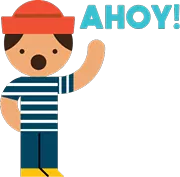You and your class set sail at the start of the school year, straight toward the idyll of learning, and now this journey is a mess! You've got disinterested sailors in the front row, a whirlpool of time-wasters in the corner, and an undisciplined crew in the back. Unless you can turn this ship around, these next few months are going to feel like you’re on the Titanic.
Take heart, Captain! It's never too late to get your classroom's compass oriented to N—for No Nonsense, kiddos. Your colleagues, many of them master navigators of the classroom, have plenty of time-tested, effective advice.
Be Direct and Talk with the Crew
 "Every day is a new day," says Peg Scholl, a Missouri second-grade teacher, who has calmly and capably captained her classroom for more than 30 years. Scholl, who also trains new teachers in her state's I Can Do It! classroom management workshops, adds, "It's never too late to change."
"Every day is a new day," says Peg Scholl, a Missouri second-grade teacher, who has calmly and capably captained her classroom for more than 30 years. Scholl, who also trains new teachers in her state's I Can Do It! classroom management workshops, adds, "It's never too late to change."
While you may think you're hearing a bit too much from some students, seemingly trying their worst to lure you onto the rocks, it might actually be helpful to have a frank conversation with the would-be Sirens.
"My very first year, I had exactly that [chaos]. I was unfamiliar with the school structure, unfamiliar with the curriculum, and part of it was that I wasn't all that familiar with what middle school was like," recalls Kate Ortiz, a retired Iowa teacher who has taught everything from K-6 to graduate school, including special education, and who also trained new colleagues in management techniques.
"I sat down with every class—all five sections—and said, 'Things are not going well. Here are the things that I'm concerned about. And what I need to know are your suggestions for making things go better. Remember, our goal is to learn. I may not agree with every suggestion, but I will listen to them.'"
Dave Foley, a Michigan retiree, and author of Ultimate Classroom Management Handbook, also favors a direct approach. "I'll say, 'We're having trouble getting some things done and we have some control issues, and I think I'm going to have to tighten things up.…Or I'll sit down with the one kid and say, 'You're kind of making it difficult for me here. Is there anything I can do to help you to behave better?' And you listen."
Use Exit Cards and Surveys To Test the Waters
 Ortiz calls it a "survey": she asked students to write their responses to questions. What's going right in this class? What's something that should change (and how would you change it?) And "what else I want Mrs. Ortiz to know…" She reported the results to her students, as well as her responses. And she did these kinds of barometric measurements at least twice a year.
Ortiz calls it a "survey": she asked students to write their responses to questions. What's going right in this class? What's something that should change (and how would you change it?) And "what else I want Mrs. Ortiz to know…" She reported the results to her students, as well as her responses. And she did these kinds of barometric measurements at least twice a year.
Jim Burke, a California high school teacher and author of The Teacher's Essential Guide to Classroom Management, calls them "exit cards," distributed at the end of a class period. He also uses them to give a constructive voice to his students.
"The classroom is a very complicated political space. You have kids, who, on the one hand, are supposed to be learning the skills and knowledge that they need to succeed in the adult world, independently. At the same time, they're getting the message that they have no voice. 'This is just the way it is. Sit down.'"
When the waters get rough, Burke uses the cards to gather anonymous suggestions on how to improve the class. "You have to be able to follow through," Burke cautions. "If I do that, I'm going to come in the next day and say, 'I got some good comments, I definitely appreciate that, a lot of you were saying this… and so we're going to handle that another way.…' It lets them see that you're listening to them, and that you're in it together."
Recruit a Reliable First Mate
 So you get the kids on board. But you also might need some adult help—a reliable Starbuck, so to speak. While many new teachers are assigned mentors, any teacher can (and should) ask for a colleague's help. Vermont's Kathy Buley, a longtime veteran of second grade, also leads training with her colleagues and says, "It always brings me back to the belief that it's the shared colleagueship and ability to reflect on practice where we get solutions to our problems that we face daily."
So you get the kids on board. But you also might need some adult help—a reliable Starbuck, so to speak. While many new teachers are assigned mentors, any teacher can (and should) ask for a colleague's help. Vermont's Kathy Buley, a longtime veteran of second grade, also leads training with her colleagues and says, "It always brings me back to the belief that it's the shared colleagueship and ability to reflect on practice where we get solutions to our problems that we face daily."
Specifically, it can be very helpful to have a colleague visit your classroom during their prep period, Ortiz suggests. Ortiz once observed a colleague whose classroom was "way out of control, all this talking out and talking back....I visited and said, 'Here's what I noticed: How do kids get your attention?' And she said, 'They come up to me, they tap me, they yell....' 'Well, how do you want them to get your attention?'"
"Sometimes, when we're in the thick of it, we don't notice what's going on," Ortiz notes. Filming yourself can help, too.
Burke also recommends visiting other teachers' classrooms to see how they get things done. (Some good questions to ask yourself: How do they welcome students? Do their students start work immediately? What happens when students don't 'get it'?) In an extreme situation, you probably could convince your administrator to hire a substitute for you for the day.
Quick Strategies for Smoother Sailing
 Other strategies to consider: Are all your pirates parked together, conspiring to hijack your class? Ortiz changed seat assignments monthly. "I don't think it's fair to make somebody sit next to the same person for the whole year," she says. But changing seats—without setting behavior expectations, isn't going to help much, she warns.
Other strategies to consider: Are all your pirates parked together, conspiring to hijack your class? Ortiz changed seat assignments monthly. "I don't think it's fair to make somebody sit next to the same person for the whole year," she says. But changing seats—without setting behavior expectations, isn't going to help much, she warns.
So consider writing a behavior contract with your students. And "with" is the key word in that last sentence. Make clear that there are rewards and punishments for their behavior, Foley advises. He used to take his best classes outside—what fun! Those kinds of rewards create positive peer pressure to behave.
And, of course, don't forget parents. "Calling parents scares teachers—even ones who have been teaching for years! They can deal with the wildest kids in the class, but they're nervous about calling parents," Foley says. "Use the right words—say, 'Can we work together on this, can we kind of team up?' Very few parents will say they don't want to work with you."
The more allies you have on the high seas, the smoother your sailing will be.
Related Resources
Trainings and Professional Learning
Tips and Advice
Join Our Movement



